Corporate Accounting: IFRS3, Acquisition Analysis and Consolidation
VerifiedAdded on 2023/01/13
|13
|2355
|25
Report
AI Summary
This report delves into the realm of corporate accounting, providing a comprehensive analysis of key concepts and practical applications. It begins with an introduction to corporate accounting and its significance, followed by a detailed examination of International Financial Reporting Standard 3 (IFRS 3) and its implications for business combinations. The report then explores the process of identifying business combinations, the recognition and measurement principles, and the exceptions to these principles. Furthermore, the report applies these concepts to a case study involving the acquisition of Davis Ltd by Alma Corporation Ltd, including acquisition analysis and consolidation worksheet entries. The analysis includes calculating the net fair value of identifiable assets and liabilities, determining the net consideration transferred, and calculating gain from the acquisition. Finally, the report concludes by summarizing the key findings and emphasizing the importance of corporate accounting in ensuring accurate financial reporting and compliance with relevant standards.

CORPORATE
ACCOUNTING
ACCOUNTING
Paraphrase This Document
Need a fresh take? Get an instant paraphrase of this document with our AI Paraphraser

Table of Contents
INTRODUCTION...............................................................................................................3
MAIN BODY.......................................................................................................................3
Part (A)..........................................................................................................................3
PART B..............................................................................................................................7
Acquisition analysis at 1 July, 2018:.............................................................................8
Consolidation worksheet entries for Alma Ltd’s group at 30 June 2019:......................8
CONCLUSION...................................................................................................................9
REFERENCES................................................................................................................10
INTRODUCTION...............................................................................................................3
MAIN BODY.......................................................................................................................3
Part (A)..........................................................................................................................3
PART B..............................................................................................................................7
Acquisition analysis at 1 July, 2018:.............................................................................8
Consolidation worksheet entries for Alma Ltd’s group at 30 June 2019:......................8
CONCLUSION...................................................................................................................9
REFERENCES................................................................................................................10

INTRODUCTION
The term corporate accounting can be defined as a way of accounting that deals
with accounting for business entities for preparation of final accounts (Domino and
Blanton, 2015). It is quite crucial field which covers almost whole tasks and activities
concerned with recording and reporting of financial information. Accounting personnels
and financial division of corporation cumulatively establish corporate accounting-
structure. The major distinction here in conventional accounting practices and corporate
accounting practices is that corporate accounting interacts primarily with complying with
accounting practices, principles and regulations in publicly listed entities, not with
normal businesses. Corporate accounting is much wider field which is not limited to
recording to fiscal event but also it support timely and proper compliances of rules,
guidelines and standards prescribed by relevant authorities and bodies. The project
report is categorised into two parts A and B. Part A is about international financial
reporting standard 3 and part B is based on acquisition analysis on the basis of given
data.
MAIN BODY
Part (A)
How to determine whether a transaction is a business combination based on
AASB3/IFRS3.
The international financial reporting standard was reissued on January 2008 and
this is applicable for reporting of annual time frame commencing after 1st of July, 2009
(About AASB 3, 2019). The main objective of this standard is to enhance relevance,
reliability and compatibility of monetary information that is included in the financial
statements. This standard has below mentioned principles which are as follows:
Identifies and assess in its financial statements the recognisable assets
acquired. As well as the liabilities assumed and any non controlling interest in the
acquiree.
Identifies and assess the goodwill acquired in business combination from a
bargain purchase.
The term corporate accounting can be defined as a way of accounting that deals
with accounting for business entities for preparation of final accounts (Domino and
Blanton, 2015). It is quite crucial field which covers almost whole tasks and activities
concerned with recording and reporting of financial information. Accounting personnels
and financial division of corporation cumulatively establish corporate accounting-
structure. The major distinction here in conventional accounting practices and corporate
accounting practices is that corporate accounting interacts primarily with complying with
accounting practices, principles and regulations in publicly listed entities, not with
normal businesses. Corporate accounting is much wider field which is not limited to
recording to fiscal event but also it support timely and proper compliances of rules,
guidelines and standards prescribed by relevant authorities and bodies. The project
report is categorised into two parts A and B. Part A is about international financial
reporting standard 3 and part B is based on acquisition analysis on the basis of given
data.
MAIN BODY
Part (A)
How to determine whether a transaction is a business combination based on
AASB3/IFRS3.
The international financial reporting standard was reissued on January 2008 and
this is applicable for reporting of annual time frame commencing after 1st of July, 2009
(About AASB 3, 2019). The main objective of this standard is to enhance relevance,
reliability and compatibility of monetary information that is included in the financial
statements. This standard has below mentioned principles which are as follows:
Identifies and assess in its financial statements the recognisable assets
acquired. As well as the liabilities assumed and any non controlling interest in the
acquiree.
Identifies and assess the goodwill acquired in business combination from a
bargain purchase.
⊘ This is a preview!⊘
Do you want full access?
Subscribe today to unlock all pages.

Trusted by 1+ million students worldwide
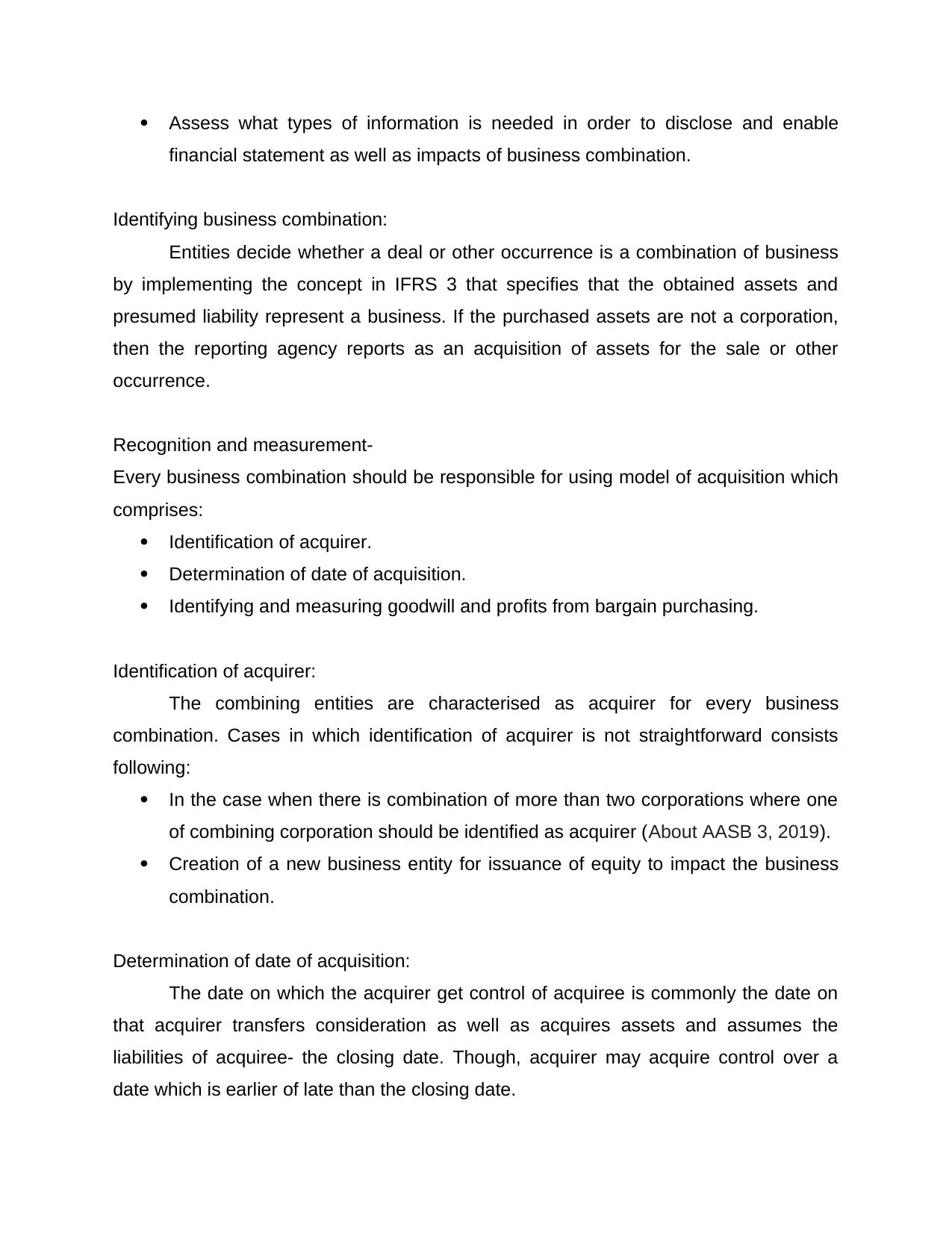
Assess what types of information is needed in order to disclose and enable
financial statement as well as impacts of business combination.
Identifying business combination:
Entities decide whether a deal or other occurrence is a combination of business
by implementing the concept in IFRS 3 that specifies that the obtained assets and
presumed liability represent a business. If the purchased assets are not a corporation,
then the reporting agency reports as an acquisition of assets for the sale or other
occurrence.
Recognition and measurement-
Every business combination should be responsible for using model of acquisition which
comprises:
Identification of acquirer.
Determination of date of acquisition.
Identifying and measuring goodwill and profits from bargain purchasing.
Identification of acquirer:
The combining entities are characterised as acquirer for every business
combination. Cases in which identification of acquirer is not straightforward consists
following:
In the case when there is combination of more than two corporations where one
of combining corporation should be identified as acquirer (About AASB 3, 2019).
Creation of a new business entity for issuance of equity to impact the business
combination.
Determination of date of acquisition:
The date on which the acquirer get control of acquiree is commonly the date on
that acquirer transfers consideration as well as acquires assets and assumes the
liabilities of acquiree- the closing date. Though, acquirer may acquire control over a
date which is earlier of late than the closing date.
financial statement as well as impacts of business combination.
Identifying business combination:
Entities decide whether a deal or other occurrence is a combination of business
by implementing the concept in IFRS 3 that specifies that the obtained assets and
presumed liability represent a business. If the purchased assets are not a corporation,
then the reporting agency reports as an acquisition of assets for the sale or other
occurrence.
Recognition and measurement-
Every business combination should be responsible for using model of acquisition which
comprises:
Identification of acquirer.
Determination of date of acquisition.
Identifying and measuring goodwill and profits from bargain purchasing.
Identification of acquirer:
The combining entities are characterised as acquirer for every business
combination. Cases in which identification of acquirer is not straightforward consists
following:
In the case when there is combination of more than two corporations where one
of combining corporation should be identified as acquirer (About AASB 3, 2019).
Creation of a new business entity for issuance of equity to impact the business
combination.
Determination of date of acquisition:
The date on which the acquirer get control of acquiree is commonly the date on
that acquirer transfers consideration as well as acquires assets and assumes the
liabilities of acquiree- the closing date. Though, acquirer may acquire control over a
date which is earlier of late than the closing date.
Paraphrase This Document
Need a fresh take? Get an instant paraphrase of this document with our AI Paraphraser
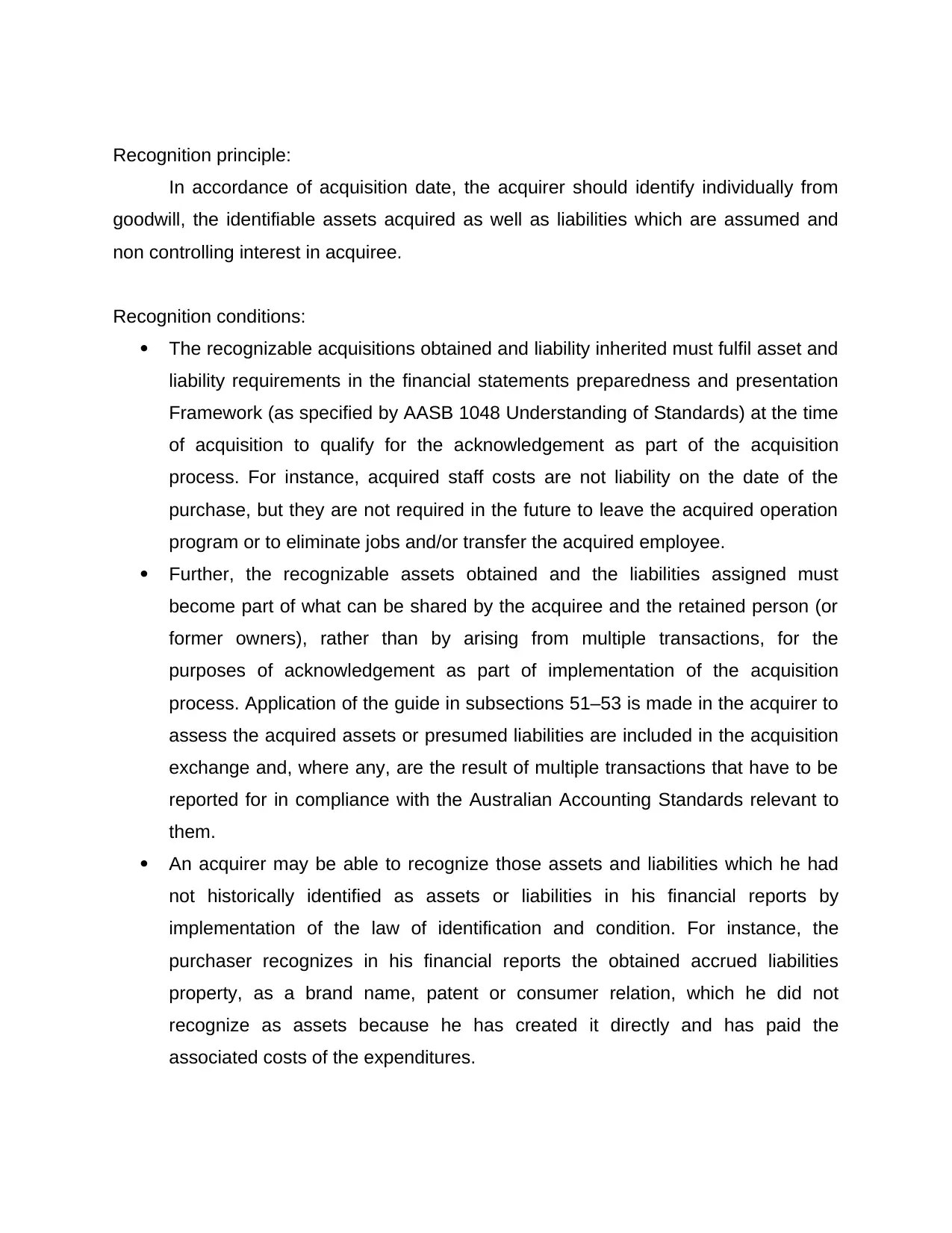
Recognition principle:
In accordance of acquisition date, the acquirer should identify individually from
goodwill, the identifiable assets acquired as well as liabilities which are assumed and
non controlling interest in acquiree.
Recognition conditions:
The recognizable acquisitions obtained and liability inherited must fulfil asset and
liability requirements in the financial statements preparedness and presentation
Framework (as specified by AASB 1048 Understanding of Standards) at the time
of acquisition to qualify for the acknowledgement as part of the acquisition
process. For instance, acquired staff costs are not liability on the date of the
purchase, but they are not required in the future to leave the acquired operation
program or to eliminate jobs and/or transfer the acquired employee.
Further, the recognizable assets obtained and the liabilities assigned must
become part of what can be shared by the acquiree and the retained person (or
former owners), rather than by arising from multiple transactions, for the
purposes of acknowledgement as part of implementation of the acquisition
process. Application of the guide in subsections 51–53 is made in the acquirer to
assess the acquired assets or presumed liabilities are included in the acquisition
exchange and, where any, are the result of multiple transactions that have to be
reported for in compliance with the Australian Accounting Standards relevant to
them.
An acquirer may be able to recognize those assets and liabilities which he had
not historically identified as assets or liabilities in his financial reports by
implementation of the law of identification and condition. For instance, the
purchaser recognizes in his financial reports the obtained accrued liabilities
property, as a brand name, patent or consumer relation, which he did not
recognize as assets because he has created it directly and has paid the
associated costs of the expenditures.
In accordance of acquisition date, the acquirer should identify individually from
goodwill, the identifiable assets acquired as well as liabilities which are assumed and
non controlling interest in acquiree.
Recognition conditions:
The recognizable acquisitions obtained and liability inherited must fulfil asset and
liability requirements in the financial statements preparedness and presentation
Framework (as specified by AASB 1048 Understanding of Standards) at the time
of acquisition to qualify for the acknowledgement as part of the acquisition
process. For instance, acquired staff costs are not liability on the date of the
purchase, but they are not required in the future to leave the acquired operation
program or to eliminate jobs and/or transfer the acquired employee.
Further, the recognizable assets obtained and the liabilities assigned must
become part of what can be shared by the acquiree and the retained person (or
former owners), rather than by arising from multiple transactions, for the
purposes of acknowledgement as part of implementation of the acquisition
process. Application of the guide in subsections 51–53 is made in the acquirer to
assess the acquired assets or presumed liabilities are included in the acquisition
exchange and, where any, are the result of multiple transactions that have to be
reported for in compliance with the Australian Accounting Standards relevant to
them.
An acquirer may be able to recognize those assets and liabilities which he had
not historically identified as assets or liabilities in his financial reports by
implementation of the law of identification and condition. For instance, the
purchaser recognizes in his financial reports the obtained accrued liabilities
property, as a brand name, patent or consumer relation, which he did not
recognize as assets because he has created it directly and has paid the
associated costs of the expenditures.
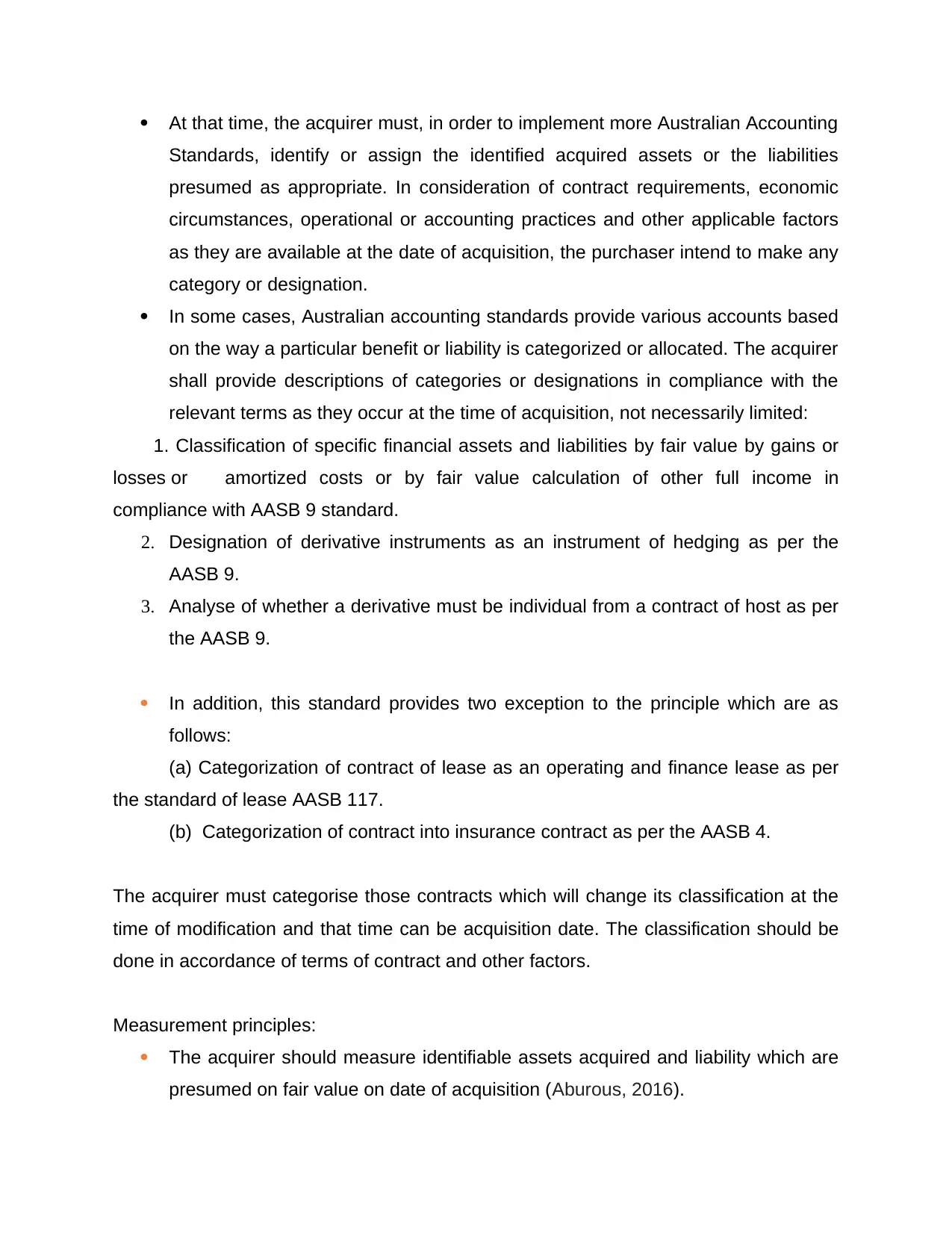
At that time, the acquirer must, in order to implement more Australian Accounting
Standards, identify or assign the identified acquired assets or the liabilities
presumed as appropriate. In consideration of contract requirements, economic
circumstances, operational or accounting practices and other applicable factors
as they are available at the date of acquisition, the purchaser intend to make any
category or designation.
In some cases, Australian accounting standards provide various accounts based
on the way a particular benefit or liability is categorized or allocated. The acquirer
shall provide descriptions of categories or designations in compliance with the
relevant terms as they occur at the time of acquisition, not necessarily limited:
1. Classification of specific financial assets and liabilities by fair value by gains or
losses or amortized costs or by fair value calculation of other full income in
compliance with AASB 9 standard.
2. Designation of derivative instruments as an instrument of hedging as per the
AASB 9.
3. Analyse of whether a derivative must be individual from a contract of host as per
the AASB 9.
In addition, this standard provides two exception to the principle which are as
follows:
(a) Categorization of contract of lease as an operating and finance lease as per
the standard of lease AASB 117.
(b) Categorization of contract into insurance contract as per the AASB 4.
The acquirer must categorise those contracts which will change its classification at the
time of modification and that time can be acquisition date. The classification should be
done in accordance of terms of contract and other factors.
Measurement principles:
The acquirer should measure identifiable assets acquired and liability which are
presumed on fair value on date of acquisition (Aburous, 2016).
Standards, identify or assign the identified acquired assets or the liabilities
presumed as appropriate. In consideration of contract requirements, economic
circumstances, operational or accounting practices and other applicable factors
as they are available at the date of acquisition, the purchaser intend to make any
category or designation.
In some cases, Australian accounting standards provide various accounts based
on the way a particular benefit or liability is categorized or allocated. The acquirer
shall provide descriptions of categories or designations in compliance with the
relevant terms as they occur at the time of acquisition, not necessarily limited:
1. Classification of specific financial assets and liabilities by fair value by gains or
losses or amortized costs or by fair value calculation of other full income in
compliance with AASB 9 standard.
2. Designation of derivative instruments as an instrument of hedging as per the
AASB 9.
3. Analyse of whether a derivative must be individual from a contract of host as per
the AASB 9.
In addition, this standard provides two exception to the principle which are as
follows:
(a) Categorization of contract of lease as an operating and finance lease as per
the standard of lease AASB 117.
(b) Categorization of contract into insurance contract as per the AASB 4.
The acquirer must categorise those contracts which will change its classification at the
time of modification and that time can be acquisition date. The classification should be
done in accordance of terms of contract and other factors.
Measurement principles:
The acquirer should measure identifiable assets acquired and liability which are
presumed on fair value on date of acquisition (Aburous, 2016).
⊘ This is a preview!⊘
Do you want full access?
Subscribe today to unlock all pages.

Trusted by 1+ million students worldwide
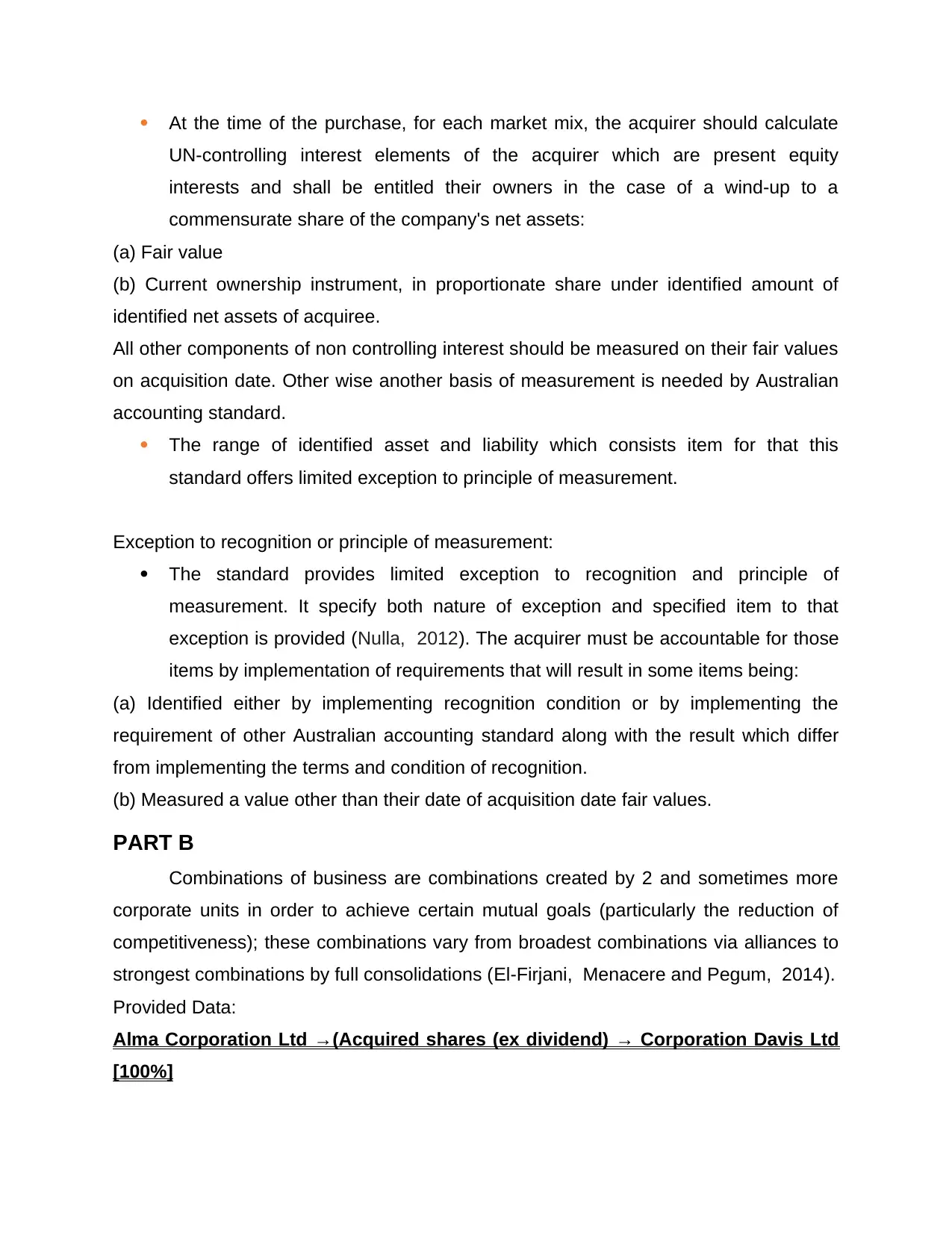
At the time of the purchase, for each market mix, the acquirer should calculate
UN-controlling interest elements of the acquirer which are present equity
interests and shall be entitled their owners in the case of a wind-up to a
commensurate share of the company's net assets:
(a) Fair value
(b) Current ownership instrument, in proportionate share under identified amount of
identified net assets of acquiree.
All other components of non controlling interest should be measured on their fair values
on acquisition date. Other wise another basis of measurement is needed by Australian
accounting standard.
The range of identified asset and liability which consists item for that this
standard offers limited exception to principle of measurement.
Exception to recognition or principle of measurement:
The standard provides limited exception to recognition and principle of
measurement. It specify both nature of exception and specified item to that
exception is provided (Nulla, 2012). The acquirer must be accountable for those
items by implementation of requirements that will result in some items being:
(a) Identified either by implementing recognition condition or by implementing the
requirement of other Australian accounting standard along with the result which differ
from implementing the terms and condition of recognition.
(b) Measured a value other than their date of acquisition date fair values.
PART B
Combinations of business are combinations created by 2 and sometimes more
corporate units in order to achieve certain mutual goals (particularly the reduction of
competitiveness); these combinations vary from broadest combinations via alliances to
strongest combinations by full consolidations (El-Firjani, Menacere and Pegum, 2014).
Provided Data:
Alma Corporation Ltd →(Acquired shares (ex dividend) → Corporation Davis Ltd
[100%]
UN-controlling interest elements of the acquirer which are present equity
interests and shall be entitled their owners in the case of a wind-up to a
commensurate share of the company's net assets:
(a) Fair value
(b) Current ownership instrument, in proportionate share under identified amount of
identified net assets of acquiree.
All other components of non controlling interest should be measured on their fair values
on acquisition date. Other wise another basis of measurement is needed by Australian
accounting standard.
The range of identified asset and liability which consists item for that this
standard offers limited exception to principle of measurement.
Exception to recognition or principle of measurement:
The standard provides limited exception to recognition and principle of
measurement. It specify both nature of exception and specified item to that
exception is provided (Nulla, 2012). The acquirer must be accountable for those
items by implementation of requirements that will result in some items being:
(a) Identified either by implementing recognition condition or by implementing the
requirement of other Australian accounting standard along with the result which differ
from implementing the terms and condition of recognition.
(b) Measured a value other than their date of acquisition date fair values.
PART B
Combinations of business are combinations created by 2 and sometimes more
corporate units in order to achieve certain mutual goals (particularly the reduction of
competitiveness); these combinations vary from broadest combinations via alliances to
strongest combinations by full consolidations (El-Firjani, Menacere and Pegum, 2014).
Provided Data:
Alma Corporation Ltd →(Acquired shares (ex dividend) → Corporation Davis Ltd
[100%]
Paraphrase This Document
Need a fresh take? Get an instant paraphrase of this document with our AI Paraphraser
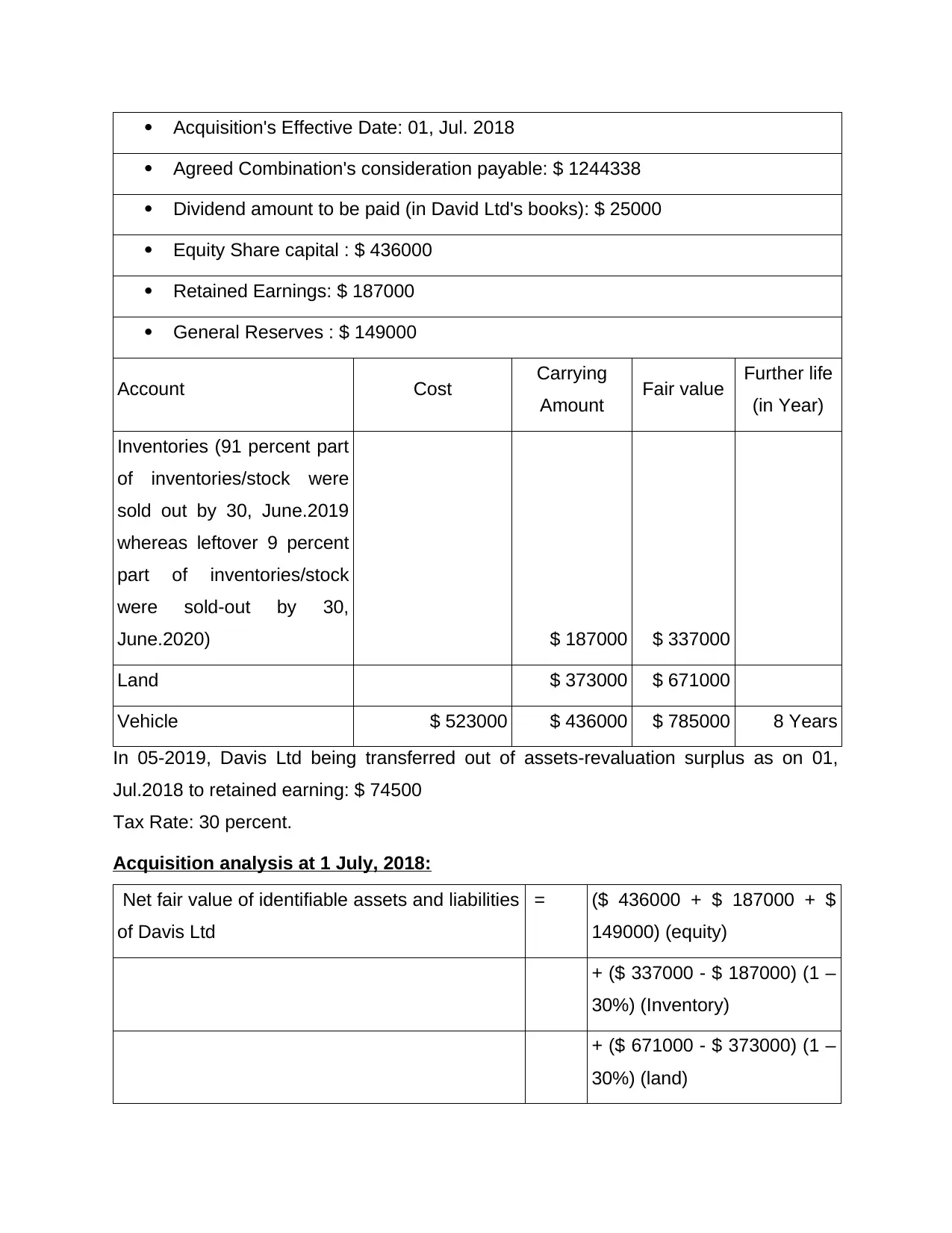
Acquisition's Effective Date: 01, Jul. 2018
Agreed Combination's consideration payable: $ 1244338
Dividend amount to be paid (in David Ltd's books): $ 25000
Equity Share capital : $ 436000
Retained Earnings: $ 187000
General Reserves : $ 149000
Account Cost Carrying
Amount Fair value Further life
(in Year)
Inventories (91 percent part
of inventories/stock were
sold out by 30, June.2019
whereas leftover 9 percent
part of inventories/stock
were sold-out by 30,
June.2020) $ 187000 $ 337000
Land $ 373000 $ 671000
Vehicle $ 523000 $ 436000 $ 785000 8 Years
In 05-2019, Davis Ltd being transferred out of assets-revaluation surplus as on 01,
Jul.2018 to retained earning: $ 74500
Tax Rate: 30 percent.
Acquisition analysis at 1 July, 2018:
Net fair value of identifiable assets and liabilities
of Davis Ltd
= ($ 436000 + $ 187000 + $
149000) (equity)
+ ($ 337000 - $ 187000) (1 –
30%) (Inventory)
+ ($ 671000 - $ 373000) (1 –
30%) (land)
Agreed Combination's consideration payable: $ 1244338
Dividend amount to be paid (in David Ltd's books): $ 25000
Equity Share capital : $ 436000
Retained Earnings: $ 187000
General Reserves : $ 149000
Account Cost Carrying
Amount Fair value Further life
(in Year)
Inventories (91 percent part
of inventories/stock were
sold out by 30, June.2019
whereas leftover 9 percent
part of inventories/stock
were sold-out by 30,
June.2020) $ 187000 $ 337000
Land $ 373000 $ 671000
Vehicle $ 523000 $ 436000 $ 785000 8 Years
In 05-2019, Davis Ltd being transferred out of assets-revaluation surplus as on 01,
Jul.2018 to retained earning: $ 74500
Tax Rate: 30 percent.
Acquisition analysis at 1 July, 2018:
Net fair value of identifiable assets and liabilities
of Davis Ltd
= ($ 436000 + $ 187000 + $
149000) (equity)
+ ($ 337000 - $ 187000) (1 –
30%) (Inventory)
+ ($ 671000 - $ 373000) (1 –
30%) (land)
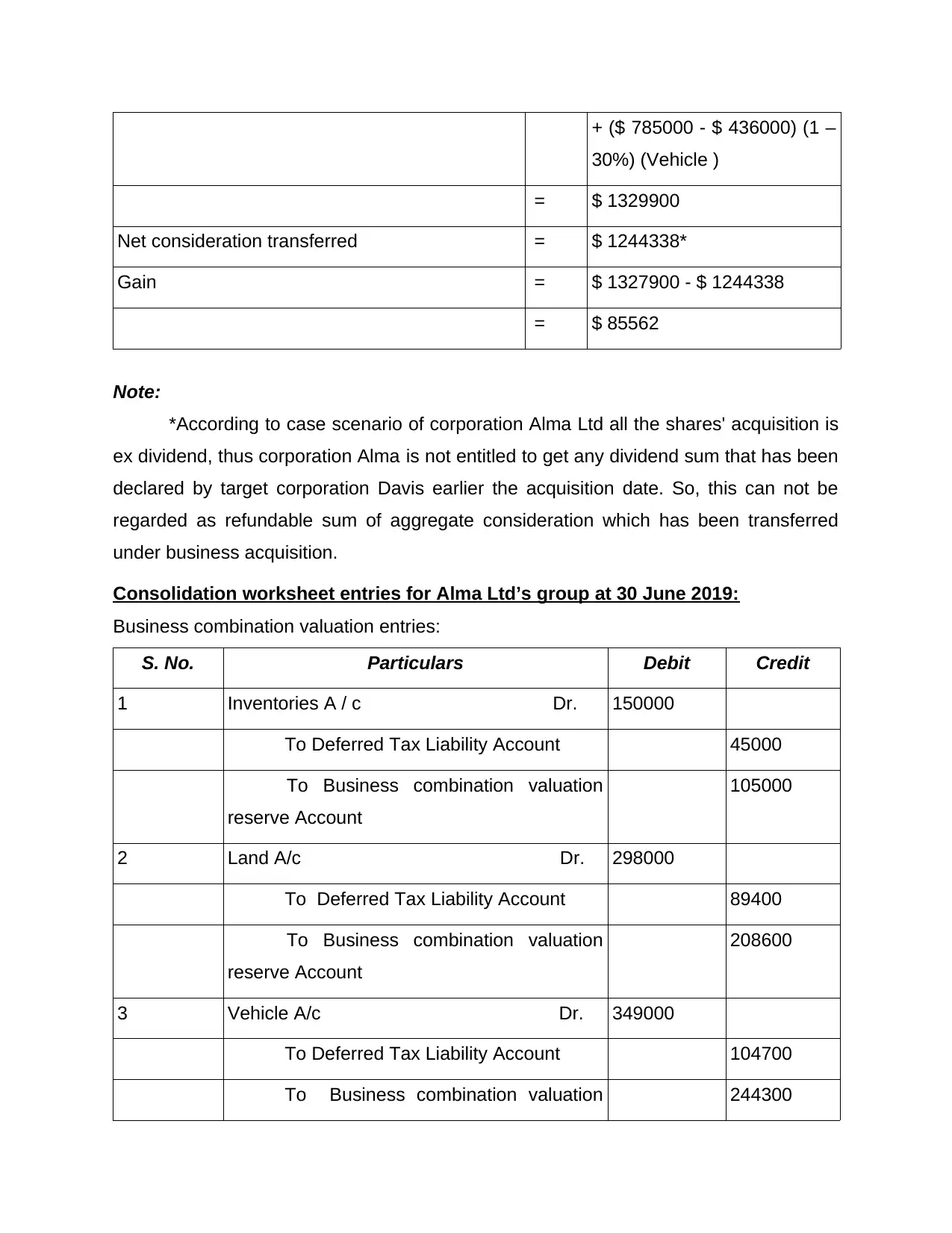
+ ($ 785000 - $ 436000) (1 –
30%) (Vehicle )
= $ 1329900
Net consideration transferred = $ 1244338*
Gain = $ 1327900 - $ 1244338
= $ 85562
Note:
*According to case scenario of corporation Alma Ltd all the shares' acquisition is
ex dividend, thus corporation Alma is not entitled to get any dividend sum that has been
declared by target corporation Davis earlier the acquisition date. So, this can not be
regarded as refundable sum of aggregate consideration which has been transferred
under business acquisition.
Consolidation worksheet entries for Alma Ltd’s group at 30 June 2019:
Business combination valuation entries:
S. No. Particulars Debit Credit
1 Inventories A / c Dr. 150000
To Deferred Tax Liability Account 45000
To Business combination valuation
reserve Account
105000
2 Land A/c Dr. 298000
To Deferred Tax Liability Account 89400
To Business combination valuation
reserve Account
208600
3 Vehicle A/c Dr. 349000
To Deferred Tax Liability Account 104700
To Business combination valuation 244300
30%) (Vehicle )
= $ 1329900
Net consideration transferred = $ 1244338*
Gain = $ 1327900 - $ 1244338
= $ 85562
Note:
*According to case scenario of corporation Alma Ltd all the shares' acquisition is
ex dividend, thus corporation Alma is not entitled to get any dividend sum that has been
declared by target corporation Davis earlier the acquisition date. So, this can not be
regarded as refundable sum of aggregate consideration which has been transferred
under business acquisition.
Consolidation worksheet entries for Alma Ltd’s group at 30 June 2019:
Business combination valuation entries:
S. No. Particulars Debit Credit
1 Inventories A / c Dr. 150000
To Deferred Tax Liability Account 45000
To Business combination valuation
reserve Account
105000
2 Land A/c Dr. 298000
To Deferred Tax Liability Account 89400
To Business combination valuation
reserve Account
208600
3 Vehicle A/c Dr. 349000
To Deferred Tax Liability Account 104700
To Business combination valuation 244300
⊘ This is a preview!⊘
Do you want full access?
Subscribe today to unlock all pages.

Trusted by 1+ million students worldwide
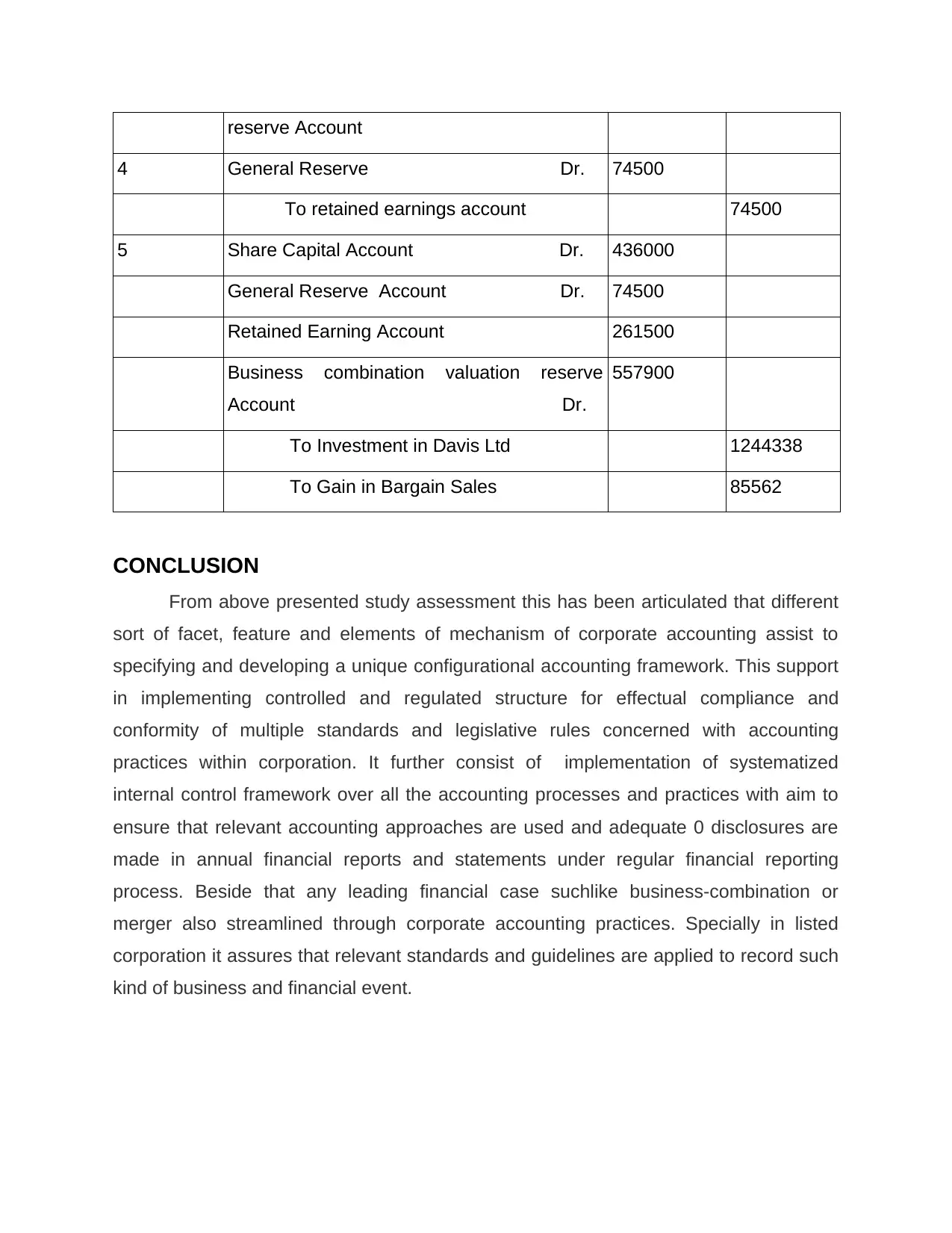
reserve Account
4 General Reserve Dr. 74500
To retained earnings account 74500
5 Share Capital Account Dr. 436000
General Reserve Account Dr. 74500
Retained Earning Account 261500
Business combination valuation reserve
Account Dr.
557900
To Investment in Davis Ltd 1244338
To Gain in Bargain Sales 85562
CONCLUSION
From above presented study assessment this has been articulated that different
sort of facet, feature and elements of mechanism of corporate accounting assist to
specifying and developing a unique configurational accounting framework. This support
in implementing controlled and regulated structure for effectual compliance and
conformity of multiple standards and legislative rules concerned with accounting
practices within corporation. It further consist of implementation of systematized
internal control framework over all the accounting processes and practices with aim to
ensure that relevant accounting approaches are used and adequate 0 disclosures are
made in annual financial reports and statements under regular financial reporting
process. Beside that any leading financial case suchlike business-combination or
merger also streamlined through corporate accounting practices. Specially in listed
corporation it assures that relevant standards and guidelines are applied to record such
kind of business and financial event.
4 General Reserve Dr. 74500
To retained earnings account 74500
5 Share Capital Account Dr. 436000
General Reserve Account Dr. 74500
Retained Earning Account 261500
Business combination valuation reserve
Account Dr.
557900
To Investment in Davis Ltd 1244338
To Gain in Bargain Sales 85562
CONCLUSION
From above presented study assessment this has been articulated that different
sort of facet, feature and elements of mechanism of corporate accounting assist to
specifying and developing a unique configurational accounting framework. This support
in implementing controlled and regulated structure for effectual compliance and
conformity of multiple standards and legislative rules concerned with accounting
practices within corporation. It further consist of implementation of systematized
internal control framework over all the accounting processes and practices with aim to
ensure that relevant accounting approaches are used and adequate 0 disclosures are
made in annual financial reports and statements under regular financial reporting
process. Beside that any leading financial case suchlike business-combination or
merger also streamlined through corporate accounting practices. Specially in listed
corporation it assures that relevant standards and guidelines are applied to record such
kind of business and financial event.
Paraphrase This Document
Need a fresh take? Get an instant paraphrase of this document with our AI Paraphraser

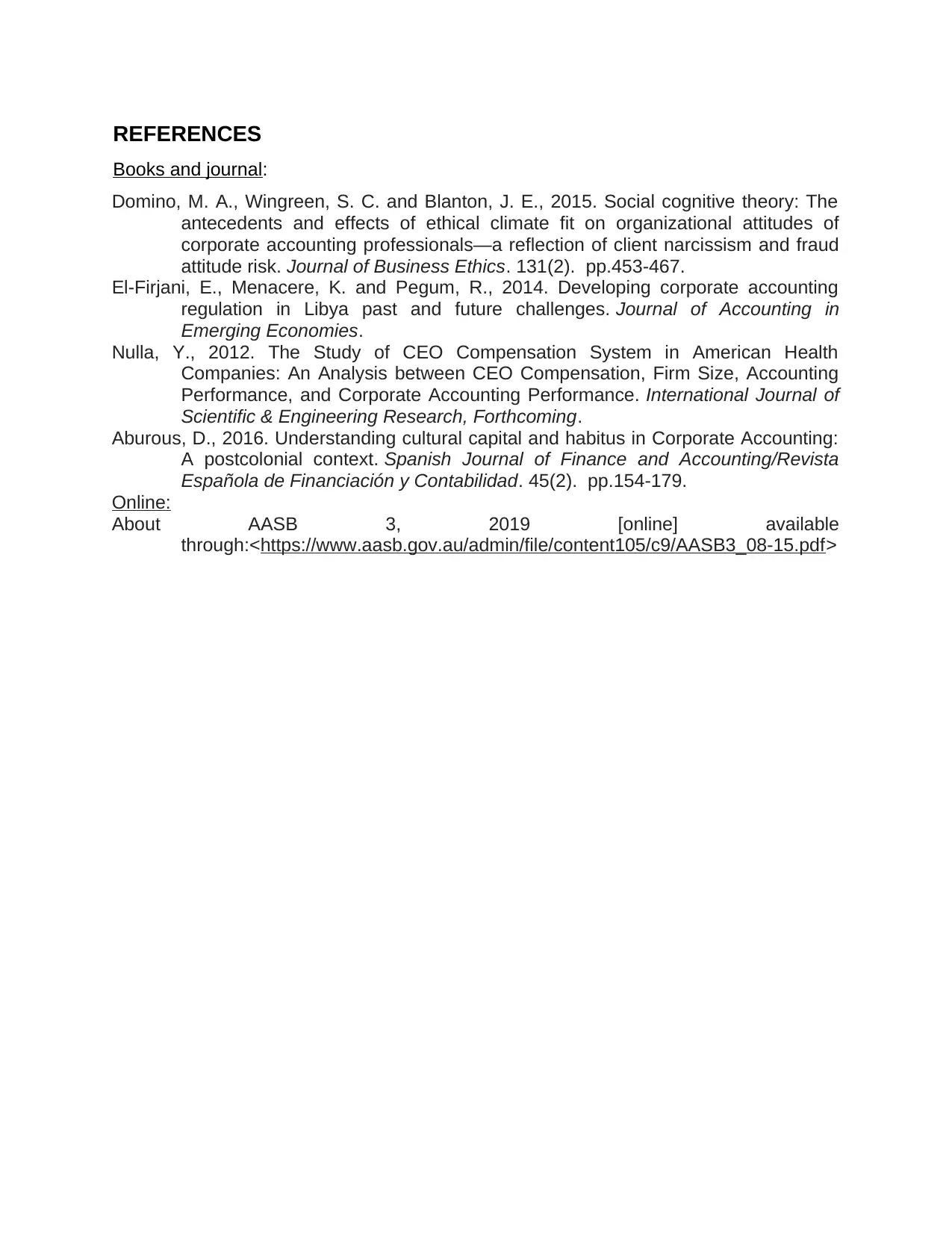
REFERENCES
Books and journal:
Domino, M. A., Wingreen, S. C. and Blanton, J. E., 2015. Social cognitive theory: The
antecedents and effects of ethical climate fit on organizational attitudes of
corporate accounting professionals—a reflection of client narcissism and fraud
attitude risk. Journal of Business Ethics. 131(2). pp.453-467.
El-Firjani, E., Menacere, K. and Pegum, R., 2014. Developing corporate accounting
regulation in Libya past and future challenges. Journal of Accounting in
Emerging Economies.
Nulla, Y., 2012. The Study of CEO Compensation System in American Health
Companies: An Analysis between CEO Compensation, Firm Size, Accounting
Performance, and Corporate Accounting Performance. International Journal of
Scientific & Engineering Research, Forthcoming.
Aburous, D., 2016. Understanding cultural capital and habitus in Corporate Accounting:
A postcolonial context. Spanish Journal of Finance and Accounting/Revista
Española de Financiación y Contabilidad. 45(2). pp.154-179.
Online:
About AASB 3, 2019 [online] available
through:<https://www.aasb.gov.au/admin/file/content105/c9/AASB3_08-15.pdf>
Books and journal:
Domino, M. A., Wingreen, S. C. and Blanton, J. E., 2015. Social cognitive theory: The
antecedents and effects of ethical climate fit on organizational attitudes of
corporate accounting professionals—a reflection of client narcissism and fraud
attitude risk. Journal of Business Ethics. 131(2). pp.453-467.
El-Firjani, E., Menacere, K. and Pegum, R., 2014. Developing corporate accounting
regulation in Libya past and future challenges. Journal of Accounting in
Emerging Economies.
Nulla, Y., 2012. The Study of CEO Compensation System in American Health
Companies: An Analysis between CEO Compensation, Firm Size, Accounting
Performance, and Corporate Accounting Performance. International Journal of
Scientific & Engineering Research, Forthcoming.
Aburous, D., 2016. Understanding cultural capital and habitus in Corporate Accounting:
A postcolonial context. Spanish Journal of Finance and Accounting/Revista
Española de Financiación y Contabilidad. 45(2). pp.154-179.
Online:
About AASB 3, 2019 [online] available
through:<https://www.aasb.gov.au/admin/file/content105/c9/AASB3_08-15.pdf>
⊘ This is a preview!⊘
Do you want full access?
Subscribe today to unlock all pages.

Trusted by 1+ million students worldwide
1 out of 13
Related Documents
Your All-in-One AI-Powered Toolkit for Academic Success.
+13062052269
info@desklib.com
Available 24*7 on WhatsApp / Email
![[object Object]](/_next/static/media/star-bottom.7253800d.svg)
Unlock your academic potential
Copyright © 2020–2025 A2Z Services. All Rights Reserved. Developed and managed by ZUCOL.




